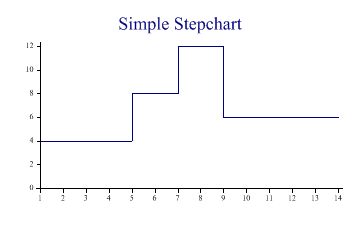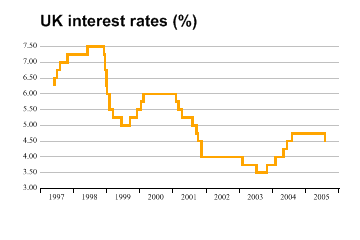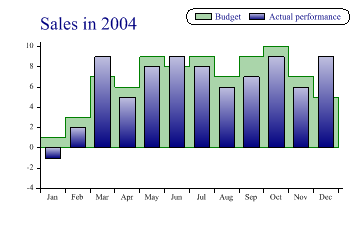| Professional charting tools for .Net developers |
Introducing SharpPlot
Your First Chart
Recent Updates
Sample Charts
General Tutorials
Reference
SharpPlot Class
Properties
Methods
Structures
Enumerations
Style examples
Glossaries
Active Charts
VectorMath Class
DBUtil Class
Get SharpPlot
Download SharpPlot
Buying SharpPlot
SharpPlot Support
Upgrading from GraPL
Release notes
Tutorials > Chart Tutorials > Stepcharts for Discontinuous Data
Stepcharts for Discontinuous Data
Step charts are used for two main chart-types. They are a very convenient way of plotting a timeseries where there may be an instantaneous change between values, which then stay fixed for some time – government interest-rates are typical. Filled stepcharts work well in combination with Barcharts, and they can also be used instead of the Histogram where data has been aggregated into categories of varying widths.
A Simple Stepchart
This chart-type is unusual in that the x-data typically has one more value than the y-data, giving the endpoint of the final plateau in the data.

ydata = new int[] {4,8,12,6};
steps = new int[] {1,5,7,9,14};
sp.YAxisStyle = YAxisStyles.ForceZero;
sp.Heading = "Simple Stepchart";
sp.DrawStepChart(ydata,steps);
Rainfall Totals by Month
The Stepchart is ideal for showing aggregated data where the groups have varying widths (in this case the months are quite similar, but we should still be honest about February). Monthly totals are written using value-tags on the top of each block.

months = new int[] {0,31,59,90,120,151,181,212,243,273,304,334,365};
monthnames = new string[]{"Jan","Feb","Mar","Apr","May","Jun","Jul","Aug","Sep",
"Oct","Nov","Dec"};
rudland = new int[] {50,67,55,103,23,95,46,61,139,98,70,87};
sp.StepChartStyle = StepChartStyles.SurfaceShading|StepChartStyles.ValueTags;
sp.SetXTickMarks(months);
sp.XAxisStyle = XAxisStyles.MiddleLabels;
sp.SetXLabels(monthnames);
sp.YAxisStyle = YAxisStyles.AtEndCaption;
sp.YCaption = "mm";
sp.SetFillStyles(FillStyle.GradientBottom);
sp.DrawStepChart(rudland,months);
Note that the month boundaries have been used for the step-points and also to set the tick-marks for the X-axis.
A Discontinuous Timeseries
This chart shows the values of the UK bank-rate over the last eight years.

sp.SetPenWidths(2.5); sp.SetColors(Color.Orange); sp.Heading = "UK interest rates (%)"; sp.HeadingStyle = HeadingStyles.Left; sp.SetHeadingFont("arial",16,FontStyle.Bold,Color.Black); sp.XAxisStyle = XAxisStyles.AnnualTicks|XAxisStyles.MiddleLabels|XAxisStyles.Clipped; sp.YAxisStyle = YAxisStyles.GridLines|YAxisStyles.InvisibleAxis; sp.YLabelFormat = "#.00"; sp.SetYRange(3,7.5); changedates = new int[] {35582,35582,35612,35643,35726,35947,36130,36141,36160, 36165,36192,36231,36323,36415,36495,36537,36568,36923,36951,36993,37105, 37151,37169,37204,37658,37812,37929,38023,38113,38141,38148,38205,38387, 38568,38580}; baserate = new double[] {6.25,6.5,6.75,7,7.25,7.5,7.25,6.75,6.25,6,5.5,5.25,5,5.25, 5.5,5.75,6,5.75,5.5,5.25,5,4.75,4.5,4,3.75,3.5,3.75,4,4.25,4.25,4.5,4.75, 4.75,4.5,4.5}; sp.DrawStepChart(baserate,changedates);
Note that the dates have been given in OLE-date format and the X-axis style is ‘Annual’ to have tickmarks placed at the year boundaries.
Budget as a Backcloth
This example combines a Stepchart with a standard Barchart to show the annual budget as a backdrop to the actual sales figures by month. In this case, the months all have a ‘notional’ width so no x-axis need be given for the steps.

budget = new int[] {1,3,7,6,9,8,9,7,9,10,7,5,5};
actual = new int[] {-1,2,9,5,8,9,8,6,7,9,6,9};
sp.Heading = "Sales in 2004";
sp.HeadingStyle = HeadingStyles.Left;
sp.SetColors(new Color[]{Color.Green,Color.Navy});
sp.SetFillStyles(new FillStyle[]{FillStyle.Halftone,FillStyle.GradientBottom});
sp.SetYRange(-3,10);
sp.Baseline = 0;
sp.XAxisStyle = XAxisStyles.MiddleLabels;
sp.SetXLabels(monthnames);
sp.StepChartStyle = StepChartStyles.SurfaceShading;
sp.DrawStepChart(budget); // see Stepsuite
sp.DrawBarChart(actual);
sp.SetKeyText(new string[]{"Budget","Actual performance"});
sp.KeyStyle = KeyStyles.TopAlign|KeyStyles.RightAlign|KeyStyles.Boxed|KeyStyles.Rounded;
Note the use of a ‘baseline’ here to have the shading and bars drawn outwards from the zero-line rather than from the X-axis. The chart has been given an explicit Y-range to allow space for the extremes from both series.
Summary
The Stepchart may be used on its own, but is often most useful in combination with other chart types.